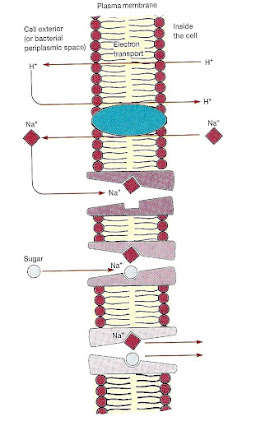Group Translocation
In active transport, solute molecules move across a membrane without modification. Many
procaryotes also take up molecules by group translocation, a process in which a molecule is
transported into the cell
while being chemically altered. The best-known group translocation system is the phosphoenolpyruvate: sugar phosphotransferase
system (PTS). It transports a variety of sugars
into procaryotic cells while phosphorylating them using phosphoenolpyruvate (PEP) as the phosphate donor.
l
HPr
and enzyme I (EI) are cytoplasmic.
l Enzyme II (EII) is composed of three subunits or domains- EIIA
is cytoplasmic and soluble. EIIB also is hydrophilic but frequently is attached to EIIC, a hydrophobic protein that
is embedded in the membrane.
1. A high-energy phosphate is transferred from PEP to enzyme II
with the aid of
enzyme I and HPr .
2. A sugar molecule is phosphorylated as it is carried
across the membrane by enzyme II.
Members of
the genera
Escherichia, Salmonella, Staphylococcus, and other facultatively anaerobic bacteria have
phosphotransferase systems;
Some obligately anaerobic bacteria (e.g., Clostridium) also have PTSs.
Many carbohydrates are transported by these systems. E. coli takes up glucose, fructose,
mannitol, sucrose, glycerol, N- acetylglucosamine, cellobiose, and other carbohydrates by group translocation.
Almost all microorganisms require iron for use in cytochromes and many enzymes. Iron uptake is made difficult by the extreme insolubility of ferric iron (Fe3+) Little free iron is available for transport. Many bacteria and fungi have overcome this difficulty by secreting siderophores [Greek for iron bearers].
Siderophores are low molecular weight molecules that are able
to
complex with ferric iron
and supply it to the cell. These iron-transport molecules are normally either hydroxamates, phenolates or catecholates. Ferrichrome is a hydroxamate produced by many fungi; Enterobactin is the catecholate formed by E.
coli.
Microorganisms secrete siderophores when little iron is available in the medium. Once the iron-siderophore
complex has reached the cell surface, it binds to a siderophore-receptor protein. Then the iron is either released
to enter the cell directly or the whole iron-siderophore complex is
transported inside by an ABC transporter. After the iron has entered the cell, it is reduced to the ferrous form (Fe2+).
Applications
of Siderophore-Producing Bacteria
Siderophore-producing bacteria are used
as biofertilizers and biocontrol agents. In iron-deficient soils,
siderophores help solubilize and transport iron, making it available to
plant roots. This improves plant nutrition, root development, and crop
yield. Siderophores compete with fungal and bacterial pathogens for
iron, limiting their growth. As biocontrol agents, they protect plants from
diseases like wilt, root rot, and damping-off. Siderophore producing
bacteria such as Pseudomonas fluorescens and Bacillus subtilis are
used as PGPR (Plant Growth-Promoting Rhizobacteria).
Siderophore-producing bacteria can
help in bioremediation or cleaning up polluted environments: Siderophores
can bind to toxic metals like iron and remove these metals from
contaminated soil and water. In contaminated or nutrient-poor soils,
they can mobilize trace elements (Fe, Zn, Mn) and improve soil health.
Siderophores have promising
applications in healthcare and research: Pathogens acquire iron through
siderophores- inhibiting siderophores help in reducing their virulence
and inhibiting them. Siderophores can be used in targeted drug delivery by linking
antibiotics to siderophores, and tricking bacteria into importing the
drug along with the "iron". Sideromycins such as cefiderocol,
a siderophore-antibiotic is used against Gram-negative bacteria).Siderophore-based
imaging tools are being explored to detect infections and iron
metabolism disorders.
l Electrogenic transport- Done by transport proteins/carriers that generate voltage across a membrane by the transfer of a charge, e.g., Na+/K+ATPase exchanges 3Na + for 2K +
A proton pump (H+) is the major electrogenic pump in plants, bacteria, and fungi. - Voltages created by electrogenic pumps are sources of potential energy available to do cellular work.
l Electroneutral transport- where carriers exchange an equal number of charged particles or transport uncharged molecules
l
Porins – channels to transport larger molecules eg., aquaporin- allows water to cross the
plasma membrane
l Permeases – function more like an enzyme. Binds the substrate and then undergoes a conformation change which causes the carrier to release the substrate to the other side. Ex. lactose permeases

















